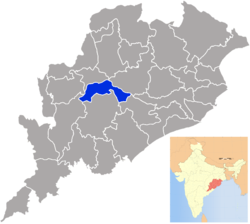Boudh District
|
Boudh ବୌଦ୍ଧ ଜିଲ୍ଲା |
|
|---|---|
| District | |
 Location in Odisha, India |
|
| Coordinates: 20°49′59″N 84°19′59″E / 20.833°N 84.333°ECoordinates: 20°49′59″N 84°19′59″E / 20.833°N 84.333°E | |
| Country |
|
| State | Odisha |
| Established | 2 January 1994 |
| Headquarters | Boudh |
| Government | |
| • Collector | Mr. Madhusudan Mishra, IAS |
| • Member of Parliament | Pratyusha Rajeswar Singh, BJD |
| Area | |
| • Total | 3,098 km2 (1,196 sq mi) |
| Population (2011) | |
| • Total | 439,917 |
| • Rank | 29 |
| • Density | 142/km2 (370/sq mi) |
| Languages | |
| • Official | Odia, English |
| Time zone | IST (UTC+5:30) |
| PIN | 762 0xx |
| Vehicle registration | OD-27 |
| Nearest city | Bhubaneswar |
| Sex ratio | 991 ♂/♀ |
| Literacy | 72.51% |
| Lok Sabha constituency | Kandhamal |
| Vidhan Sabha constituency | 2 (85-Kantamal ,86-Boudh) |
| Precipitation | 1,623.1 millimetres (63.90 in) |
| Website | boudh |
Boudh District, also called Bauda District (Odia: ) is an administrative district of Odisha state in eastern India. The city of Boudh is the district headquarters.
The early history of Boudh is still in obscurity. However, the discovery of remarkable Buddhist statues from Boudh led some scholars to believe that Boudh was an important Buddhist centre of Orissa. From the epigraphic records it is known that in the middle of the 8th century AD, Boudh region was under the occupation of the Bhanja rulers and was a part of Khinjali Mandala. The earliest known ruler of this Bhanja family was Nettabhanja who was ruling over the Dhenkanal region as independent ruler, but his successor migrated towards Boudh-Sonepur region and established Khinjali Mandala and ruled there as the feudatory of the Bhauma Karas of Tosali. The Sonepur Copper Plate of Satrubhanja Dev, son of Silabhanja mentions the name Khinjali Mandala for the first time and on this basis it is believed that Silabhanja Dev was the founder of Bhanja Kula of Khinjali Mandala. Their capital was Dhirtipura, which has been identified with Boudh town. Satrubhanja Dev – II, a ruler of this family was defeated and killed by the Somavansi ruler of South Kosala, Janmeyjaya – I. The Bhanja’s were driven out from the Boudh region which was renamed as Odra Desa. Yayati – I, the son and successor of Janmejaya – I established his capital in Odradesa at Yayatinagara, which has been identified with modern Jagati in Boudh District. The Somavansi then occupied and migrated towards Utkala leaving their original home land South-Kosala in charge of viceroys. In course of time Kosala was lost to them and was occupied by the Telugu-Chodas and the Kalachuris. The imperial Gangas of Kalinga, after their occupation of Utkala, entered into a protracted struggle with the Kalachuris for one hundred years for the occupation of Kosala region. It is evident from the Chatesvar Inscription ( 1220 AD) that the struggle finally ended in favour of the Gangas during the region of Anangabhima Deva – III and thereafter Boudh along with Sonepur came under the Ganga Rule and was administered by the Ganga Administrators. In course of time, the Ganga Administrators became semi-independent and ruled over this territory hereditarily. So far tradition goes, there emerged a Brahmin ruling family in Boudh . Gandhamardan Dev, the last Brahmin ruler of this family, being childless adopted one Ananga Bhanja of Keonjhar Bhanja royal family. He succeeded Gandharmardhan Dev and laid the foundation of the rule of the Bhanjas in Boudh in the first half of the 14th century AD. He changed his surname from Bhanja to Dev and was known as Ananga Dev. Since then, the new line of kings continued to rule over this region till the merger of Boudh State with the Orissa Province in 1948. Their kingdom comprised modern Athmallik, Boudh, and Sonepur regions with its capital headquarters at Swarnapura (Sonepur). But later on due to the expansionist policy followed by the Chouhan rulers of Patna (Patnagarh in Bolangir District) they shifted their capital to Boudh.
...
Wikipedia
